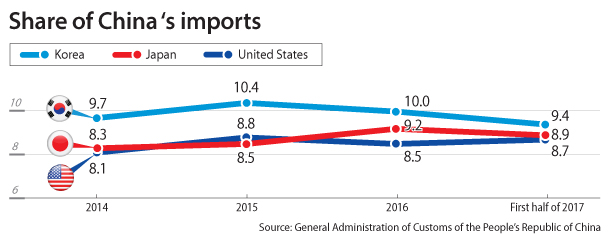Korean share of Chinese imports in single digits

According to a report released by the Beijing branch of the Korea International Trade Association on Monday, Korea managed to maintain its crown as the largest exporter to China by shipping 9.4 percent of China’s imports.
But it was the first time in three years Korea’s market share slumped into the single digit range. Korea supplied 9.7 percent of China’s imports market in 2013, and the figure had stayed above 10 percent for the intervening years.
Japan is close behind Korea with an 8.9 percent share in the Chinese import market in the first six months. Last year, Japan was behind Korea by 0.8 percentage points.
In monthly trade, the U.S. overtook Korea as the top exporter to China in March. Japan occupied the No.1 position in April and June.
“Korea is keeping its place, but it’s not a secure victory,” the Korean trade group said in the report.
Korea was the only country among the top five exporters to China that saw less than 10 percent growth. Data from the General Administration of Customs of the People’s Republic of China says imports from Korea amounted to $80.8 billion during the first half of the year, which was 9.3 percent higher than in the previous year.
Imports from Japan to China grew by 15.6 percent year on year and imports from the United States increased by 19.8 percent. Imports from Australia jumped by a whopping 55.8 percent as the country bought a lot of natural resources from Australia, the report said.
“The slow growth rate is largely due to tension created by conflict over the deployment of the U.S. antimissile system,” said Shim Yoon-sup, a director at the association’s Beijing branch. “Also, the quality of Chinese goods has greatly improved over the years, such as smartphones, reducing the need for some imports.”
Korean exports to China were led by semiconductors and petrochemicals. Exports of parts for automobiles and wireless telecommunications devices slumped.
Integrated circuit semiconductor chip exports to China increased 47.5 percent while auto part exports dropped by 38.3 percent and wireless telecommunications device parts fell by 23.2 percent, according to data from the Korea International Trade Association.
The report emphasized Korea should come up with a new strategy for the Chinese consumer market, which is becoming highly competitive as Chinese companies develop.
“Korea is still the largest exporter to China but challenges ahead are growing tougher as conflict over the missile system continues and the Chinese market eyes alternative suppliers,” Shim added.
China’s overall international trade increased for the first time in three years during the January-June period according to the report. China’s exports to other countries grew 8.5 percent year on year to $1.05 trillion while its imports expanded 18.9 percent to $862.2 billion.
BY KIM JEE-HEE [kim.jeehee@joongang.co.kr]










with the Korea JoongAng Daily
To write comments, please log in to one of the accounts.
Standards Board Policy (0/250자)